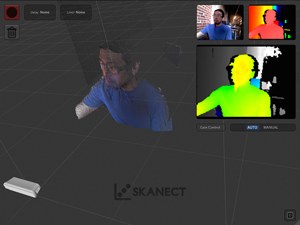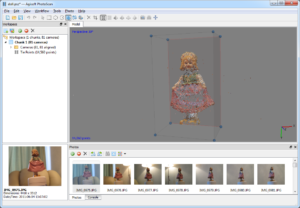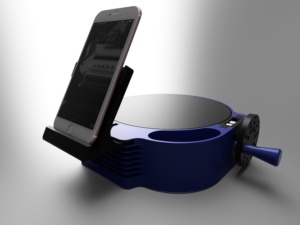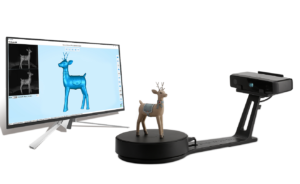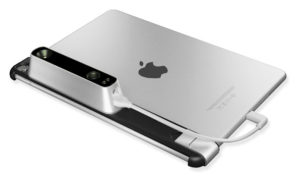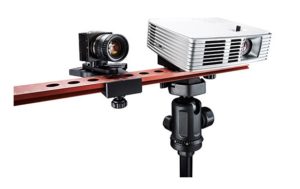3D scanning is no simple trick. I know it; I designed a full-body 3D scanning system for iMakr’s New York store in 2014, and though it wasn’t my first foray into 3D printing, it led to many other opportunities. I detailed my system in an Instructable, which was very popular, I’m sure in large part because 3D scanning is seen as a dark art. While I generally use photogrammetry for 3D scanning, using DSLRs to capture images that are then processed into a 3D model, there are other technologies out there that utilize lasers or other methods for 3D scanning. The technology is changing rapidly, with quality and ease of use improving, and more players entering the market.
What can you do with 3D scanning? A lot. 3D scanning has got you covered from head to toe, quite literally. 3D scanning is used to make custom fit footwear and we see the trend accelerating. Companies like Wiivv allow customers to use their free app to 3D scan their feet for personalized insoles. No more going into the store to get measured for mass produced sneaks. Why do that when you can get shoes made specifically to fit your feet? Feetz offers a similar service, and our own editor-in-chief, Sarah Goehrke, wrote about her experiences with her custom Feetz shoes as well as with custom Wiivv insoles. 3D scanning your noggin can help protect your brain from sports injuries. We recently reported football gear maker Riddell is using 3D scanning to make better football helmets for the NFL. Skelmet uses 3D scanning to make custom fit 3D printed sports glasses. Roger Bacon Eyewear and Yuniku use 3D scanning to make their eyeglasses. But 3D scanning is used in so many applications from medical to automotive to space exploration, that it’d be impossible to list every possible application.
- Artec EVA
In this guide I’ll lay out various options for 3D scanning, from DIY to fully automatic systems. Qualify varies greatly, as does price. If you’re willing to put in a lot of elbow grease and have the patience of a saint, then I recommend going the DIY route. If you’re looking for an inexpensive desktop scanner, I’d caution you against that. They aren’t very good and not worth the money. Spend a little more to get much better results. There are some impressive handheld scanners on the market, and you’ll pay accordingly for them. Professional 3D scanning systems are quite expensive, and they can get excellent results, but take time and training to use. Remember, 3D scanning is far from perfect, it takes time to process scans and more time to clean scans, no scan is artifact-free.
SOFTWARE & DIY OPTIONS
If you’re willing to put in the work, you can pretty good results if you build a scanning system yourself. Some solutions are software only, and some combine software and hardware. Some of those hardware options require 3D printing. If you have a 3D printer already, you might want to consider constructing your own system. Depending on the quality of your build, the software you use and your skill level, you can get professional results rivaling 3D scanning systems costing ten of thousands of dollars.
Price: Free, $129 for Skanect Pro
Technology: Photogrammetry software
Skanect is a 3D scanning software that works with many different 3D cameras, including the [easyazon_link identifier=”B016LPM94C” locale=”US” tag=”3dprint09-20″]Structure Sensor[/easyazon_link] and [easyazon_link identifier=”B00INAX3Q2″ locale=”US” tag=”3dprint09-20″]Microsoft Kinect[/easyazon_link]. It’s free for personal use and has many of the same features as the commercial version, Skanect Pro, which is $129. Skanect exports OBJ, PLY, STL and VRML. It will automatically repair models to make them watertight and can instantly export to Sketchfab, an online community sharing platform for 3D models. Export is limited to 5,000 polygons. Skanect Pro has unlimited polygon export and adds instant export to Shapeways, and can be used for commercial purposes. Though I have yet to use it myself, Skanect sounds like a great software choice for hobbyists and enthusiasts. Professional users seem happy with the pro version, which is very affordable.
Resolution: N/A
Pros: Works with Structure Sensor, Microsoft Kinect and Asus Xtion. Free for non-commercial purposes. Mac and Windows compatible.
Cons: Requires a computer with a lot of processing power. Export limited to 5,000 polygons.
Price: $179 for the Standard Edition, $3,499 for the Professional Edition
Technology: Photogrammetry software
PhotoScan is a powerful 3D scanning software that was originally developed to shoot large objects, like buildings, outdoors in natural light, which it does very well. With proper indoor lighting, PhotoScan can capture professional scans of small objects to full body scans of people. I’ve used older versions of the software, it’s currently on version 1.3.2., and it’s my go to choice, but you need a lot of light for usable photos (photos should not be edited) and it takes some practice to get the proper overlap of consecutive photos to get a good 3D scan. Fortunately, Agisoft provides very helpful tutorials on their website. The Standard Edition can be used for commercial projects and is node-based. It had pro features like spherical panorama sticking and fisheye camera support. The Professional Edition adds a host of features including 4 modeling for dynamic scenes, network processing and python scripting. Educational pricing is available for educators and students; there’s a 30 day trial version and it can be demoed on the Agisoft website.
Resolution: N/A
Pros: Works with most camera-based scanning systems, scans very small and very large objects, available for Mac, Windows and Linux.
Cons: Requires a lot of light to get good photos for processing, can get confused if photos aren’t well aligned, processing can be slow.
The $30 3D Scanner by Dave Clarke
Price: $30 or less
Technology: Photogrammetry
UK designer Dave Clarke designed a cheap 3D scanning turntable that works with your smartphone. The design is quite ingenious and can cost even less than $30, provided you already have a spare pair of earbuds. The design, a winner in the 2016 Pinshape Awards, uses your smartphone and a 3D printed turntable to scan small objects. Clarke has made several updates to make it easier to print on smaller print beds. It is a long print and requires assembling several pieces, but should be well worth the effort (I’m building one myself). He explains his process on the Pinshape blog. The system uses earbuds and the headphone jack (or lighting cable jack on iPhone 7) as a remote trigger for the phone’s camera. Turning the crank rotates the bed and nubs on the gear press on the earbuds’ volume button, trigging the camera to take a shot. A full rotation of the turntable takes 50 shots and Clarke recommends using Autodesk ReMake (formerly Momento) to process the scans.
The free version of Autodesk ReMake will process up to 50 shots. The paid version uses cloud computing and can process up to 250 shots, for $30/month or $300/year. Students and educators can use the full version for free. The downside? Autodesk ReMake no longer supports Mac, it’s Windows only. If you have a Mac you’ll need a different software solution for processing the photos. The turntable will work with iPhone and Android phones.
Resolution: N/A
Pros: Uses your smartphone’s onboard camera, inexpensive, can be used with free scanning software.
Cons: Long print time, assembly required, software is Windows-only.
Price: $199 or less
Technology: Laser triangulation
The [easyazon_link identifier=”B014G8GMEO” locale=”US” tag=”3dprint09-20″]BQ Ciclop[/easyazon_link] is an open-source project comparable to professional desktop 3D scanning systems for a fraction of the price. It can take up to a day to print, but it’s worth the effort. The scanner is composed of 3D printed parts, a web cam, two line lasers and a turnable platform with a stepper motor and control boards. 3D printable files can be found online at Pinshape, and information for the entire project is hosted on GitHub. Horus 3D scanning software was developed from scratch for the Ciclop and had its own GitHub page. Documentation can be found on this wiki, as well as documentation on CowTech Engineering‘s version of the scanning system. When properly calibrated, it is capable of impressive scans of small objects.
Resolution: 0.5mm
Pros: Open-source hardware and software, community support, uses lasers and a web camera for high resolution scans.
Cons: Long print time, requires assembly and additional parts, can be difficult to calibrate lasers.
DESKTOP SCANNERS
These are all-in-one systems for scanning small objects and have integrated automatic turntables. Scanning small objects is difficult, but these systems have been optimized for doing just that. They are meant to be used indoors, tethered to a computer. Depending on the scanning technology employed, you’ll either need a lot of light, or you’ll want to scan in complete darkness and let the scanning system illuminate the object itself. They require calibration and usually come with some kind of calibration card.
Price: $1,199
Technology: Structured Light
The [easyazon_link identifier=”B07111K9NM” locale=”US” tag=”3dprint09-20″]EinScan-SE[/easyazon_link] is an improvement on Shining 3D’s popular EinScan-S, and a bargain next to its big brother the [easyazon_link identifier=”B071S8BK9M” locale=”US” tag=”3dprint09-20″]EinScan-SP[/easyazon_link], which is $1,100 more. The system includes a turntable and a small, portable tripod for scanning larger objects. It can scan larger objects, 70 x 70 x 70 cm, for a fixed, manual scan, and 20 x 20 x 20 cm, for an automatic turntable scan. Calibrating the scanner can take some trial and error, and scanning should be conducted in darkness, as ambient light will affect the structured light scan. I’ve used the previous version of the EinScan and I believe it’s one of the best desktop scanners for the money.
Resolution: 0.1mm
Pros: High resolution scans at an affordable price, can be used to scan larger objects with the included tripod.
Cons: Calibration can be tricky and there’s no back button if you make a mistake, software loads slowly.
Price: $499.99
Technology: Laser triangulation
The Matter and Form 3D scanner is an affordable, highly portable option. Resolution and accuracy are comparable with many pro systems, however quality of scans is not always that good, so it is best suited for education and demonstration purposes. Requires a lot of light for accurate scans. It has difficulty picking up dark colored objects. Scanning can be slow; taller items can take up to 45 minutes to scan.
Resolution: 0.43mm
Pros: Portable, easy to set up, high resolution. 1-click watertight meshes for 3D printing and animation. Mac and Windows compatible.
Cons: Scan quality is low. Scanning is slow.
HANDHELD SCANNERS
Portable and lightweight, handheld scanners are surprisingly versatile and are good for a variety of applications, from scanning objects to full-body scans of people. Scanning is done by hand and it’s not a good application for animals or children, as subjects need to be stationary for longer periods of time. Best for indoor use.
Price: $349 – $499
Technology: Photogrammetry
The [easyazon_link identifier=”B016LPM94C” locale=”US” tag=”3dprint09-20″]Structure Sensor[/easyazon_link] remains one of the most popular handheld scanning systems on the market, for its low price and ease-of-use. For $379 you get the sensor and an iPad bracket, or you can get the $499 bundle which includes a USB “hacker” cable and Skanect Pro. It can also be used with the iPhone. For $349 you can buy the Structure Sensor without the iPad bracket and either create your own bracket or buy one through Shapeways. The hacker cable is just a USB to mini USB cable, but it allows you to connect the Structure Sensor to other USB enabled devices. The SDK is open, so there’s a lot of middleware to support the scanner. Can also be used with third-party scanning apps, such as itSeez3D (free, $6.99 per model export) and Scandy (free). The Structure Sensor has an IR sensor for depth scanning and does a good job of capturing 3D models, and it uses the iPad’s camera for color textures.
Resolution: 0.5mm
Pros: Portable, easy-to-use, tether-free. Works with iPad, iPhone. Open SDK, hackable, works with third-party apps.
Cons: Doesn’t work well outdoors, sunlight interferes with IR sensor.
Price: $199
Technology: Photogrammetry
The [easyazon_link identifier=”B06W9LMJKX” locale=”US” tag=”3dprint09-20″]XYZprinting 3D Scanner Pro[/easyazon_link] has a smooth, ergonomic design and is lightweight. At $199 it’s affordably priced. There are three scanning modes; head, object and full body. Max scan volume is 39.3″ x 39.3″ x 78.7″. Scan resolution is low and there have been complaints about connectivity and scan quality. Best meant for hobbyists, not professionals. Devices with built-in RealSense Scan modules and Windows Surface Tablets are not supported.
Resolution: 1.5mm
Pros: Inexpensive, lightweight, ergonomic, and tether-free. Powered by Intel RealSense module. Clips to tablets for increased portability.
Cons: Scan quality is mediocre at best, Windows-only, users have reported difficulty connecting to computers.
HIGH-END SCANNERS
If you have the budget and space, and require high-resolution scans for professional applications then structured light scanners may be the way to go. These systems feature high accuracy and reliability, but will require more than a passing knowledge of 3D scanning. Proper calibration is key to get good results from these systems and they require loads of processing power. Great for a wide-range of uses, from small parts to full-body scans of people,
HP 3D Structured Light Scanner Pro 3
Price: $3,699+
Technology: Structured Light
Formerly the [easyazon_link identifier=”B016Q92EM0″ locale=”US” tag=”3dprint09-20″]David SLS-3[/easyazon_link] (HP acquired David a year ago), this scanner uses structured light scanning and consists of a video projector and industrial HDMI camera with HD lens. Scans can be captured in as little as 2 seconds. The system is tripod-mounted and optional accessories include an automatic turntable for $999. The bundled DAVID 5 Pro software is compatible with Windows Vista, 7, 8, and 10. Scan sizes range from 60-500mm.
Resolution: 0.05mm
Pros: High-detail. Precise and fast. Proven technology.
Cons: Not very portable, subjects should be shot indoors. Software is Windows-only.
Price: $9,800
Technology: Structured Light
Artec’s “budget” version of their best-selling Artec Eva 3D scanner uses structured light to get highly detailed scans. It is designed to capture detailed geometry from a wide variety of subjects; mechanical parts, people, vehicles and environments. The Artec Eva Lite forgoes capturing textures for a lower price point, but can be upgraded to the Eva. The Eva upgrade will set you back $10K, but allows color tracking and capture. It works best with the Artec Studio 12 software which ranges from $600/year to $1,200/year for Artec Studio Ultimate for 1 license. An optional battery pack will let you go tether-free for up to 6 hours, for $850.
Resolution: 0.5mm
Pros: High-detail. optional battery pack, upgradeable to Artec Eva.
Cons: Doesn’t capture color textures. Doesn’t include software.
For additional thoughts on 3D scanners out there, you can still check out our previous 3D scanner buyers’ guides from 2016 and 2015. There are many 3D scanners available, and this guide only touches on 10 options. You can also check out our 2017 3D Printer Buying Guide for some options in 3D printing. There’s a lot to keep in mind when you’re in the market for 3D hardware/software, so be sure to do your research before investing in any of these technologies. Have you tried any of these scanners? Let us know your thoughts in the 3D Scanner Buying Guide forum at 3DPB.com.
Subscribe to Our Email Newsletter
Stay up-to-date on all the latest news from the 3D printing industry and receive information and offers from third party vendors.
You May Also Like
Further Understanding of 3D Printing Design at ADDITIV Design World
ADDITIV is back once again! This time, the virtual platform for additive manufacturing will be holding the first-ever edition of ADDITIV Design World on May 23rd from 9:00 AM –...
3D Printer Maker EVO-tech Reborn as NEVO3D — Once More With Feeling
EVO-tech was a 3D printing service and original equipment manufacturer established in 2013 and based in Schörfling am Attersee, Austria. The company produced high-quality material extrusion systems featuring linear bearings,...
3D Systems Brings 3D Printed PEEK Cranial Implant to the U.S. with FDA Clearance
For more than 10 years, 3D Systems (NYSE:DDD) has worked hand-in-hand with surgeons to plan over 150,000 patient-specific cases, and develop more than two million instruments and implants from its...
CDFAM Returns to Berlin for Second Annual Symposium
The second CDFAM Computational Design Symposium is scheduled for May 7-8, 2024, in Berlin, and will convene leading experts in computational design across all scales. Building upon the first event...


